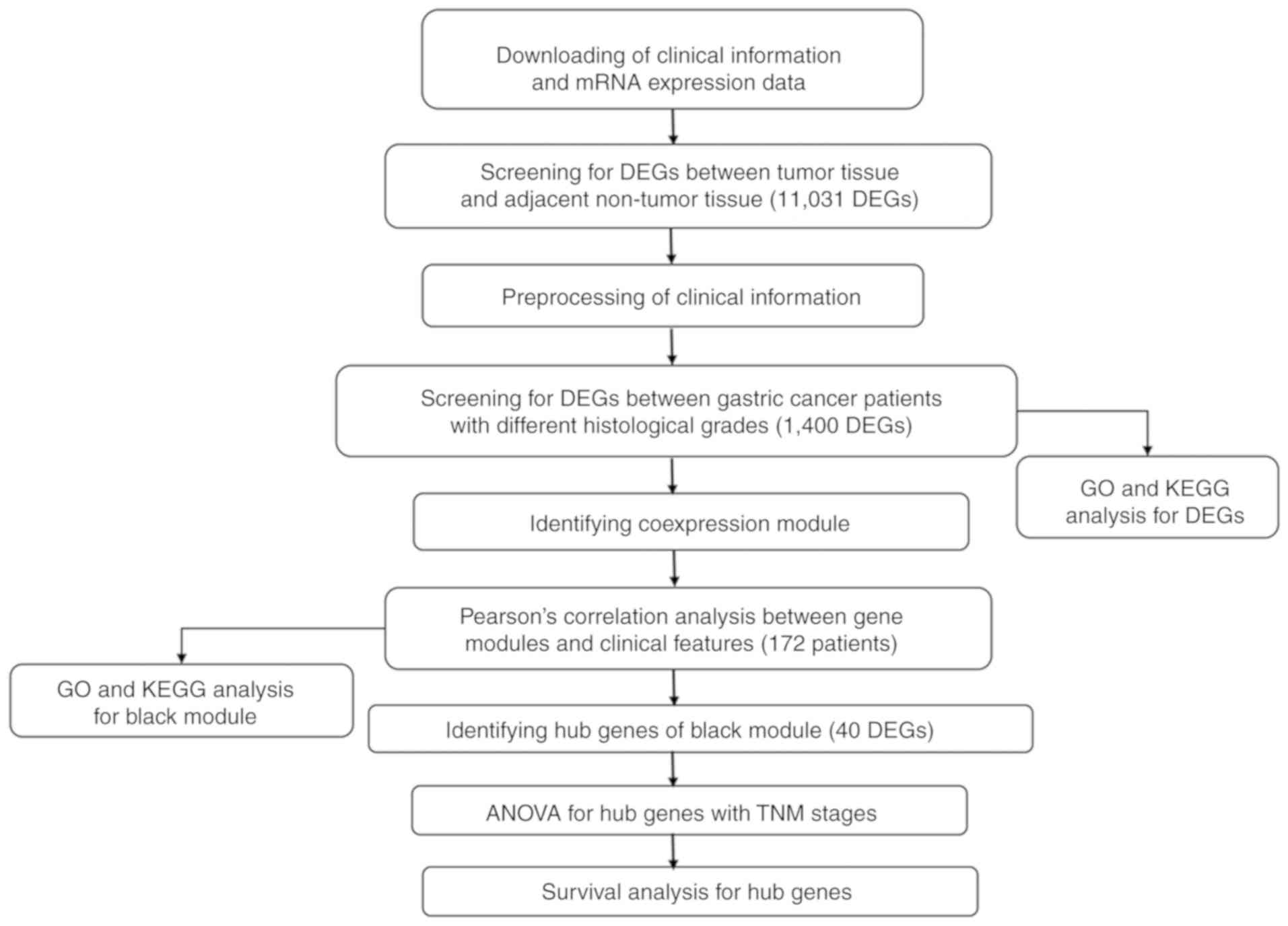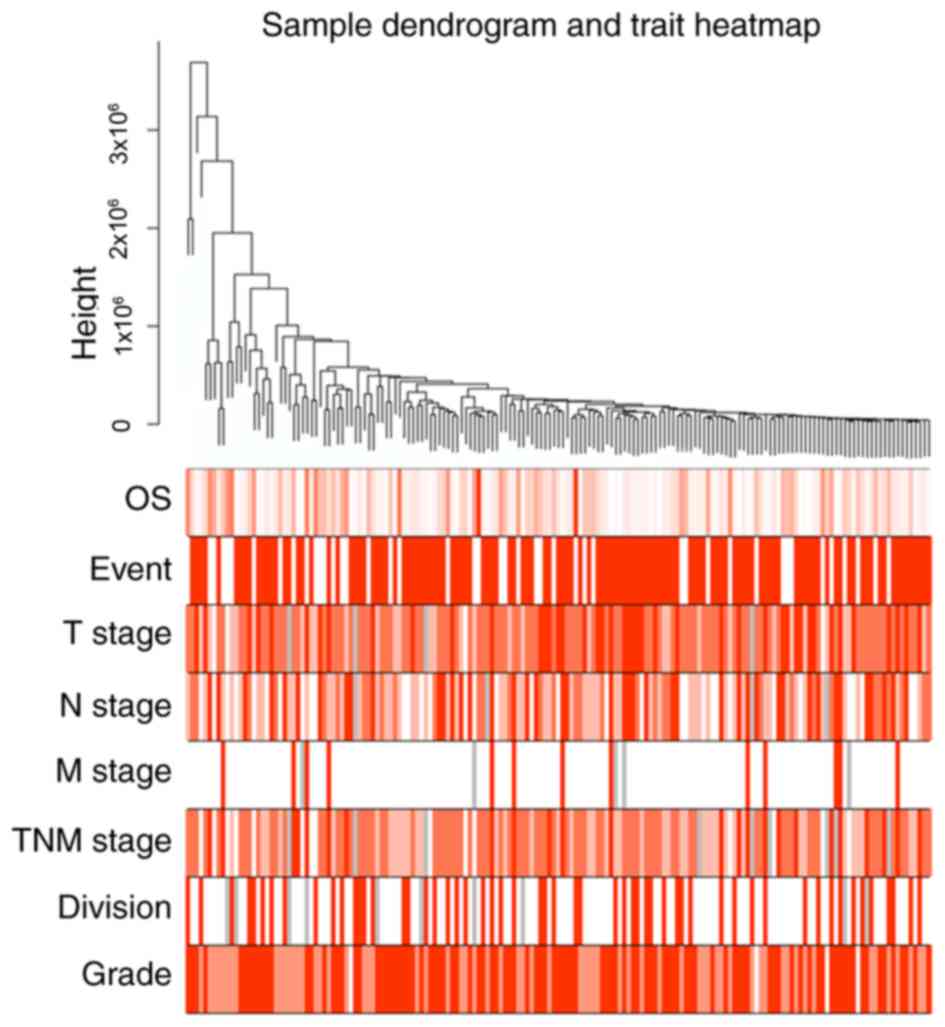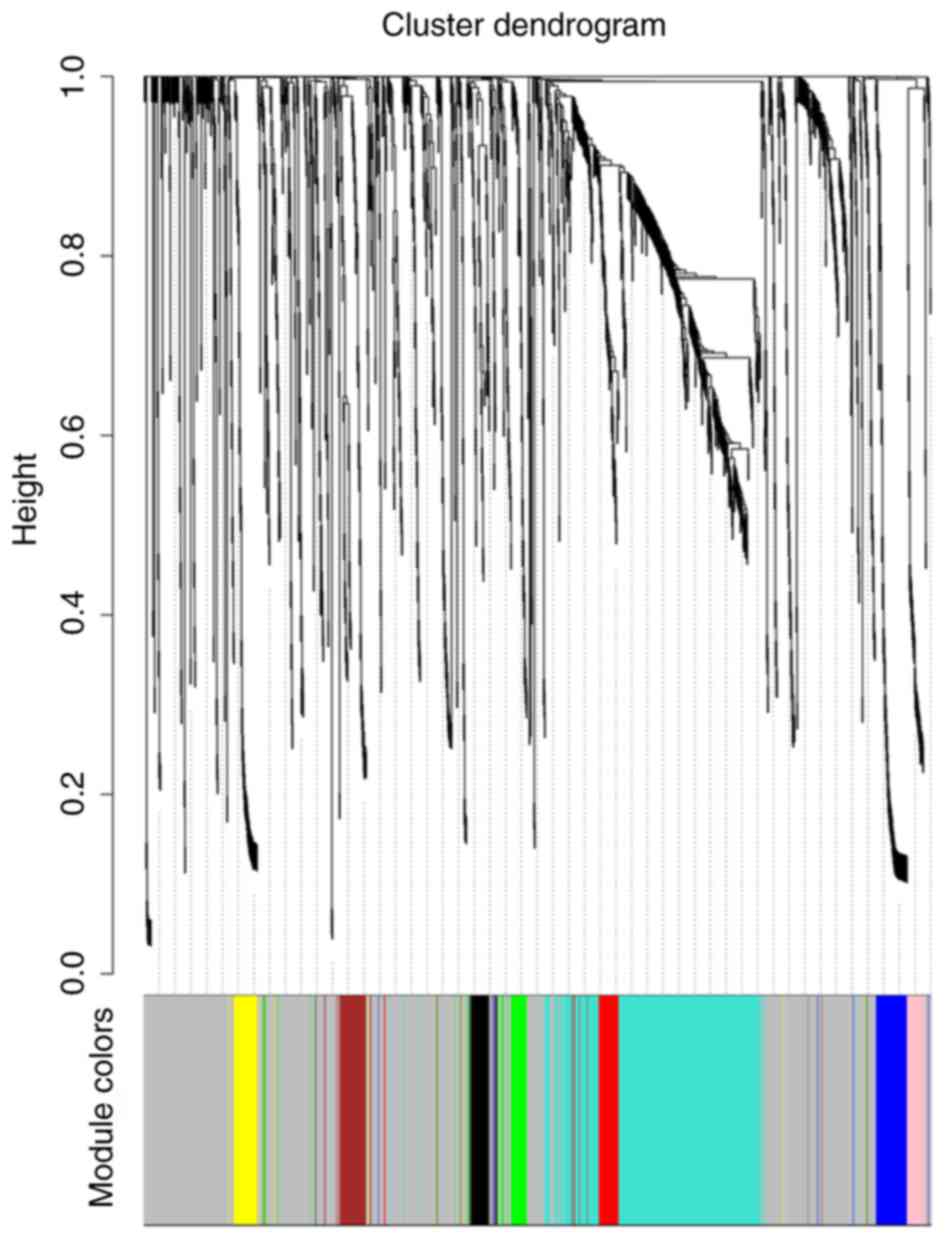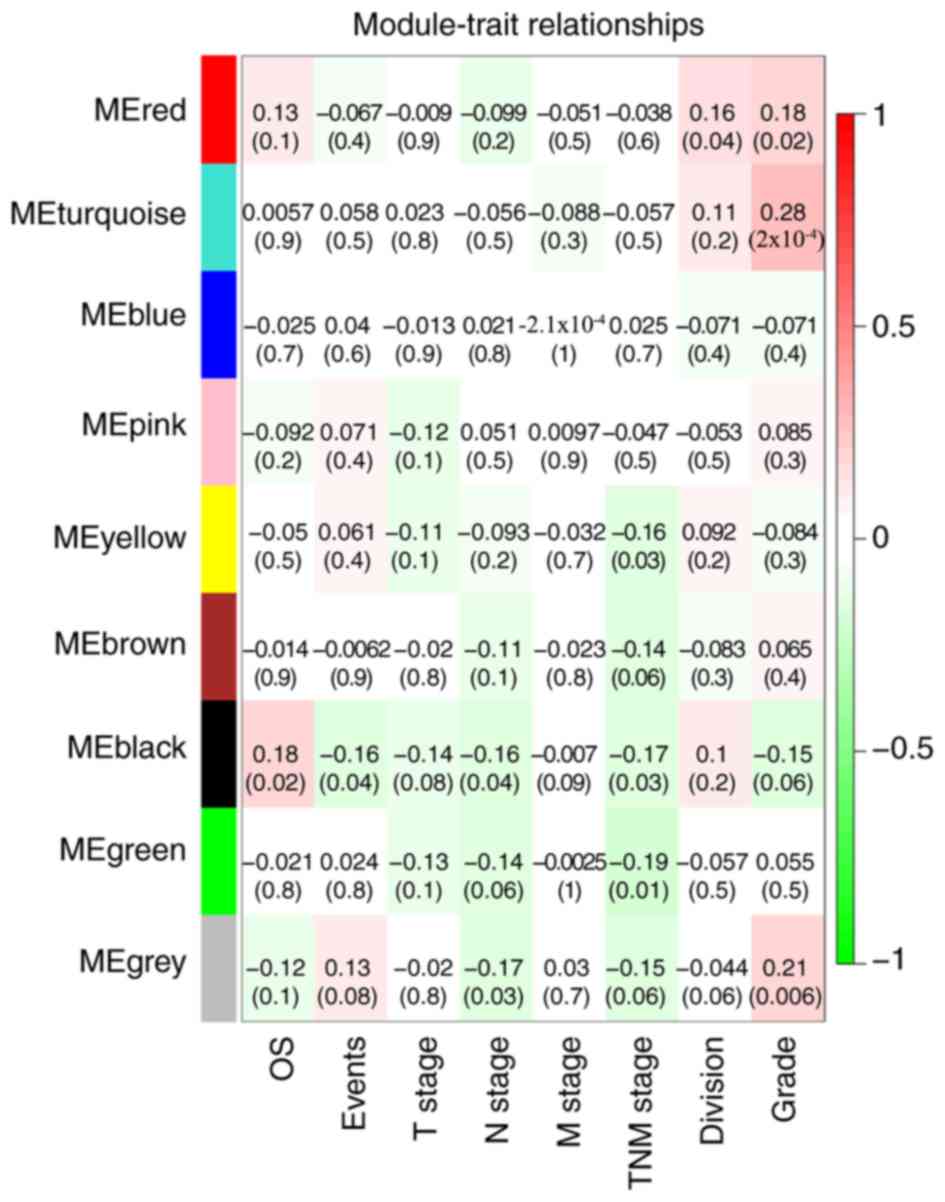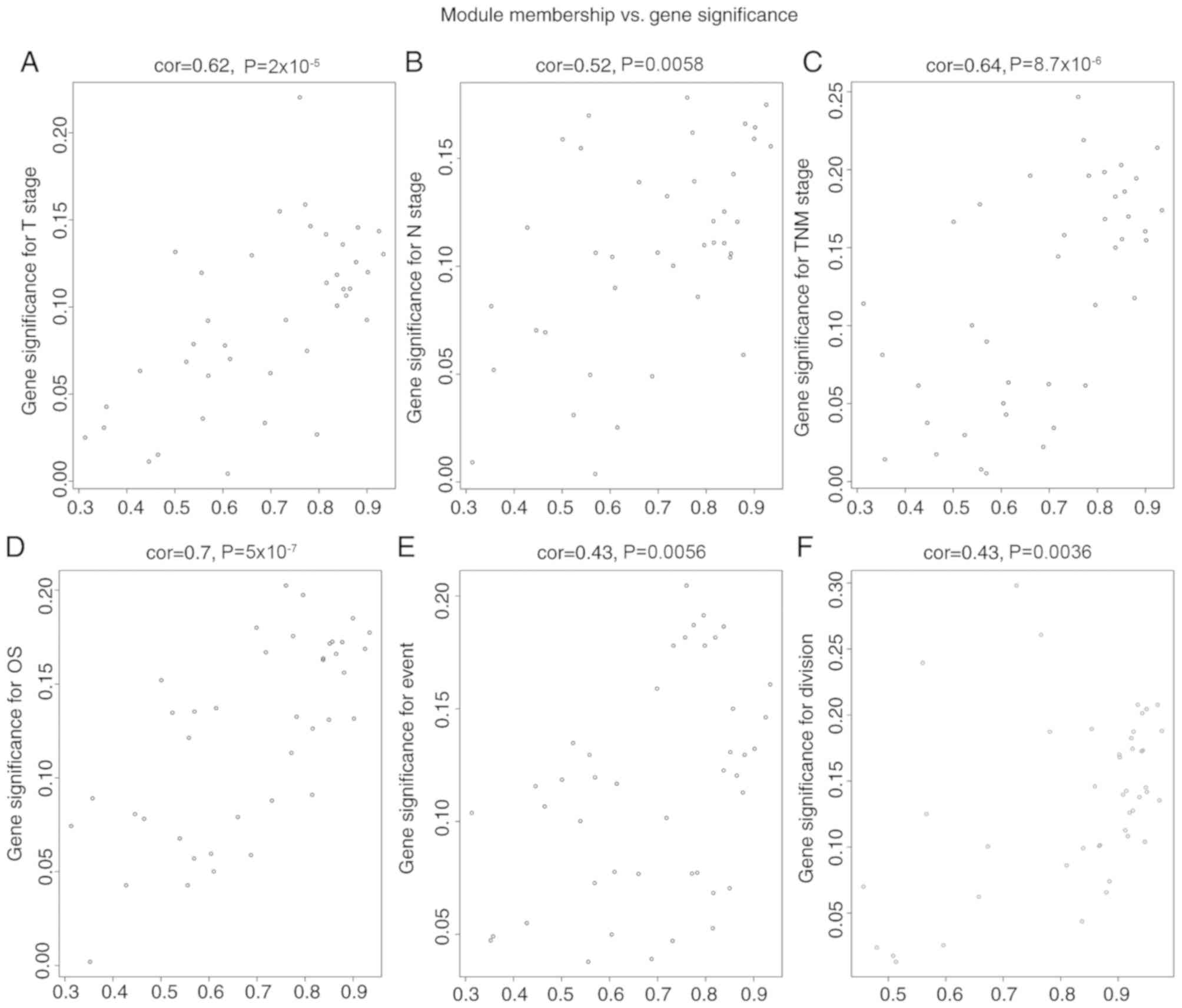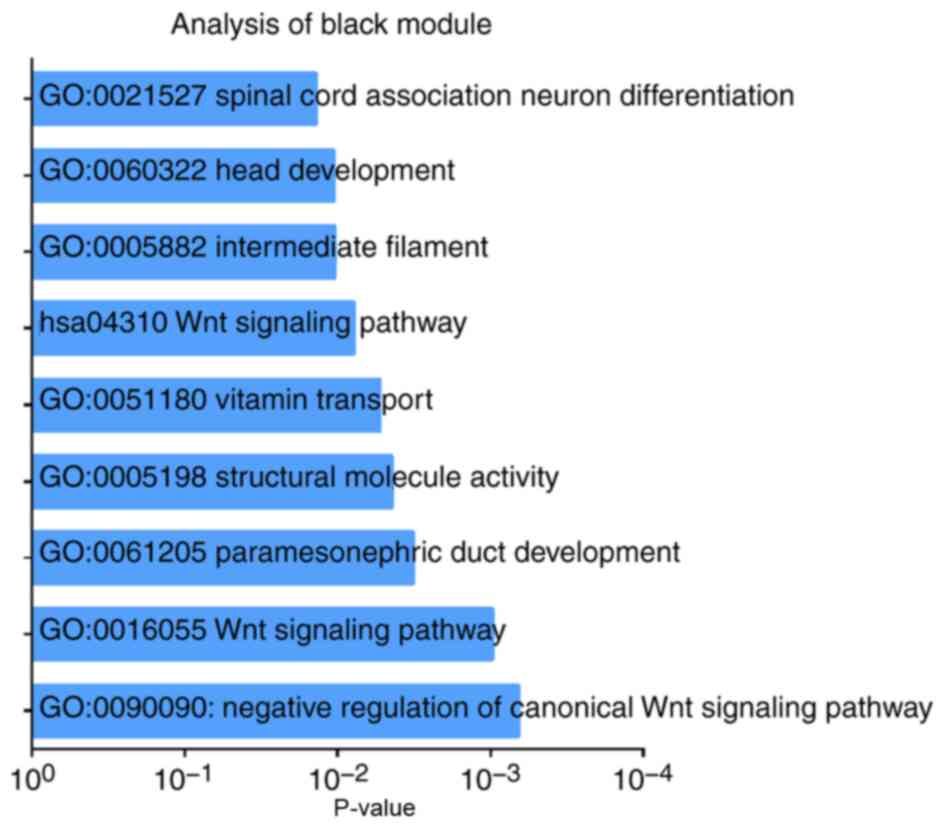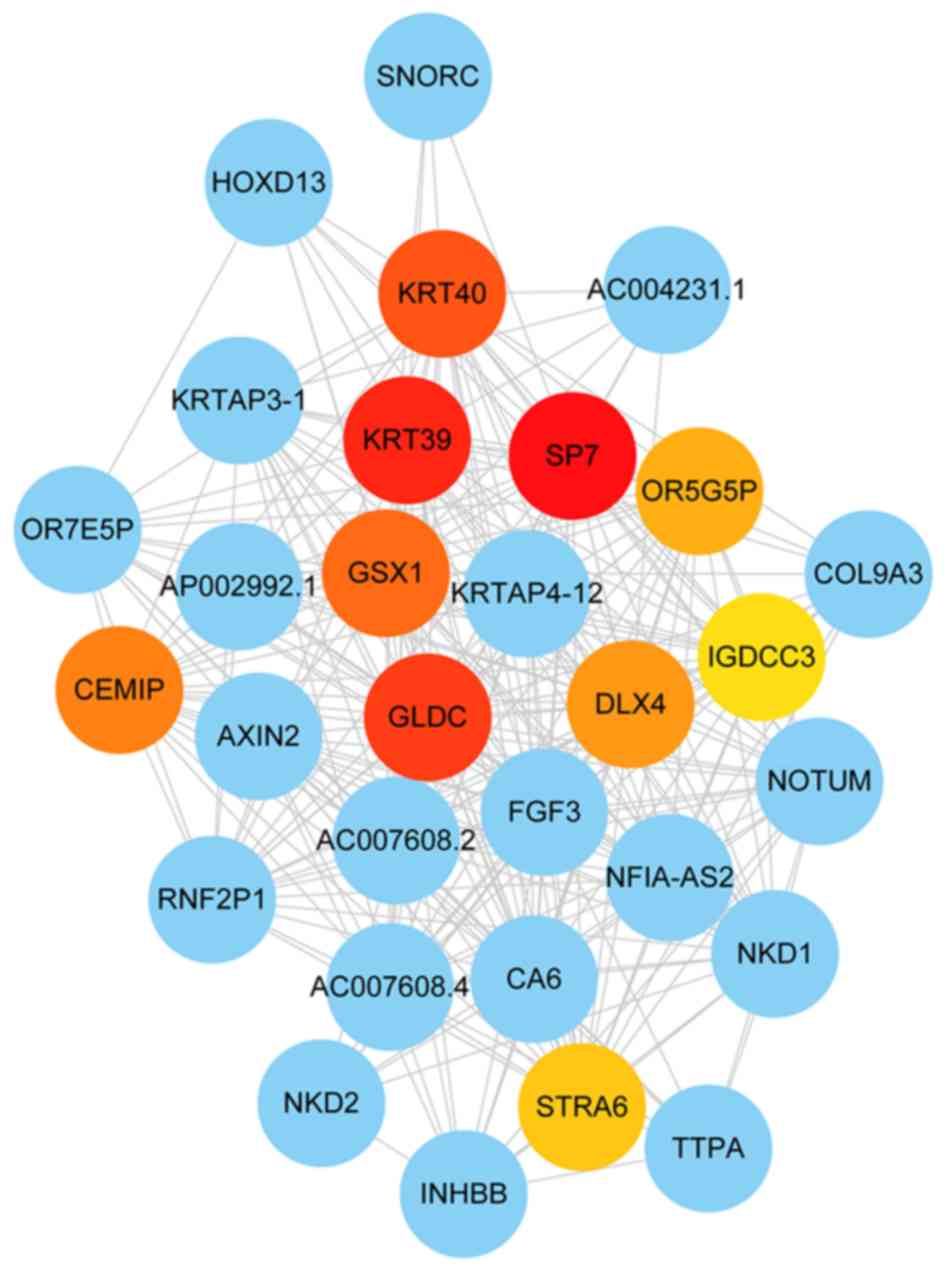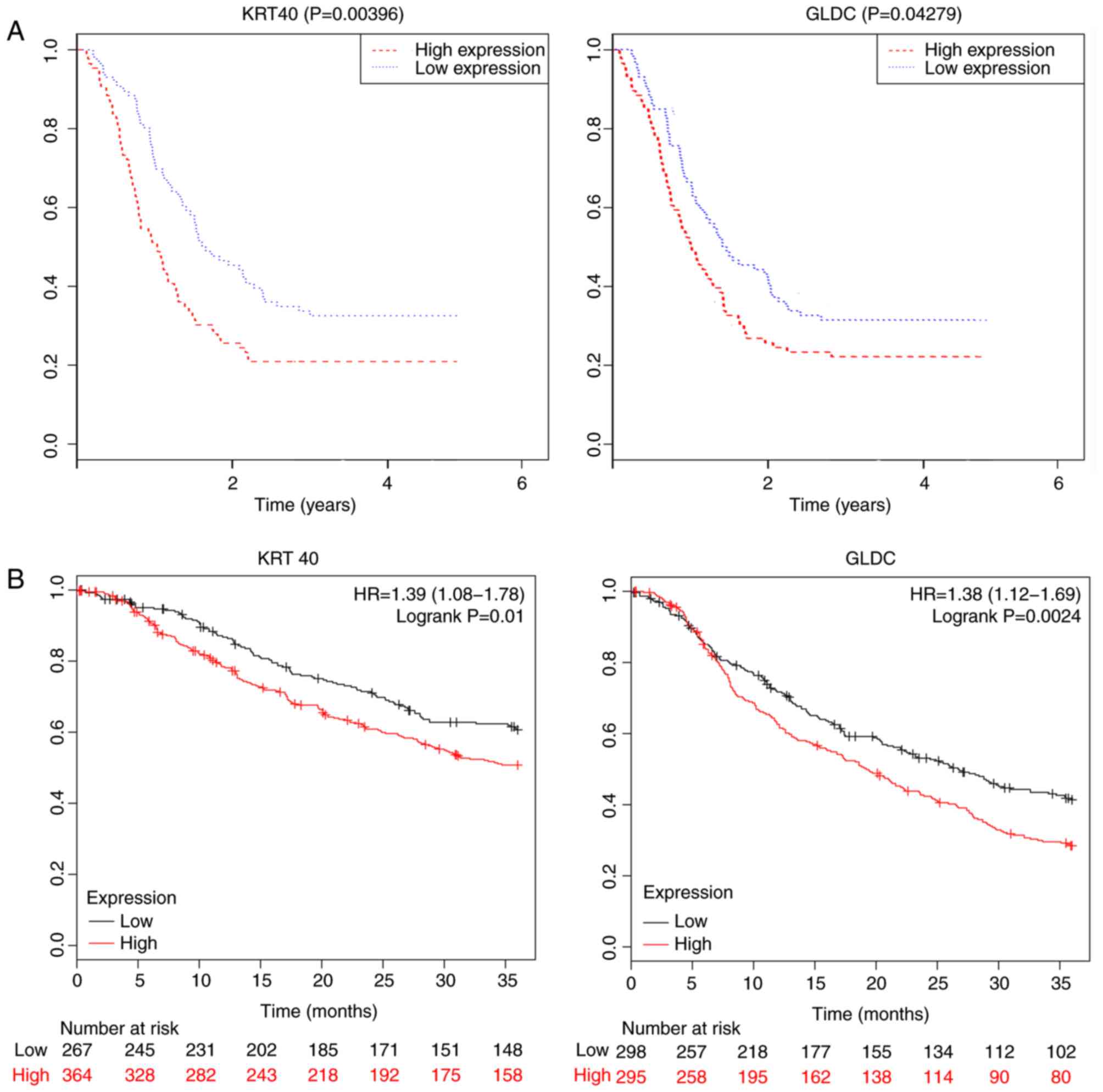|
1
|
Torre LA, Bray F, Siegel RL, Ferlay J,
Lortet-Tieulent J and Jemal A: Global cancer statistics, 2012. CA
Cancer J Clin. 65:87–108. 2015. View Article : Google Scholar : PubMed/NCBI
|
|
2
|
Folli S, Morgagni P, Roviello F, De
Manzoni G, Marrelli D, Saragoni L, Di Leo A, Gaudio M, Nanni O,
Carli A, et al: Risk factors for lymph node metastases and their
prognostic significance in early gastric cancer (EGC) for the
Italian research group for gastric cancer (IRGGC). Jpn J Clin
Oncoly. 31:495–499. 2001. View Article : Google Scholar
|
|
3
|
Popiela T, Kulig J, Kolodziejczyk P and
Sierzega M and Sierzega M; Polish Gastric Cancer Study Group, :
Long-term results of surgery for early gastric cancer. Brit J Surg.
89:1035–1042. 2002. View Article : Google Scholar : PubMed/NCBI
|
|
4
|
Adachi Y, Yasuda K, Inomata M, Sato K,
Shiraishi N and Kitano S: Pathology and prognosis of gastric
carcinoma: Well versus poorly differentiated type. Cancer.
89:1418–1424. 2000. View Article : Google Scholar : PubMed/NCBI
|
|
5
|
Noda S, Soejima K and Inokuchi K:
Clinicopathological analysis of the intestinal type and diffuse
type of gastric carcinoma. Jpn J Surg. 10:277–283. 1980. View Article : Google Scholar : PubMed/NCBI
|
|
6
|
Ribeiro MM, Sarmento JA, Sobrinho Simões
MA and Bastos J: Prognostic significance of Lauren and Ming
classifications and other pathologic parameters in gastric
carcinoma. Cancer. 47:780–784. 1981. View Article : Google Scholar : PubMed/NCBI
|
|
7
|
Kim BS, Oh ST, Yook JH and Kim BS: Signet
ring cell type and other histologic types: Differing clinical
course and prognosis in T1 gastric cancer. Surgery. 155:1030–1035.
2014. View Article : Google Scholar : PubMed/NCBI
|
|
8
|
Qiu MZ, Cai MY, Zhang DS, Wang ZQ, Wang
DS, Li YH and Xu RH: Clinicopathological characteristics and
prognostic analysis of Lauren classification in gastric
adenocarcinoma in China. J Transl Med. 11:582013. View Article : Google Scholar : PubMed/NCBI
|
|
9
|
Flucke U, Mönig SP, Baldus SE, Zirbes TK,
Bollschweiler E, Thiele J, Dienes HP and Hölscher AH: Differences
between biopsy- or specimen-related Laurén and world health
organization classification in gastric cancer. World J Surg.
26:137–140. 2002. View Article : Google Scholar : PubMed/NCBI
|
|
10
|
Langfelder P and Horvath S: WGCNA: An R
package for weighted correlation network analysis. BMC
Bioinformatics. 9:5592008. View Article : Google Scholar : PubMed/NCBI
|
|
11
|
Udyavar AR, Hoeksema MD, Clark JE, Zou Y,
Tang Z, Li Z, Li M, Chen H, Statnikov A, Shyr Y, et al:
Co-expression network analysis identifies spleen tyrosine kinase
(SYK) as a candidate oncogenic driver in a subset of small-cell
lung cancer. BMC Syst Biol. 7 (Suppl 5):S12013. View Article : Google Scholar : PubMed/NCBI
|
|
12
|
Horvath S, Zhang B, Carlson M, Lu KV, Zhu
S, Felciano RM, Laurance MF, Zhao W, Qi S, Chen Z, et al: Analysis
of oncogenic signaling networks in glioblastoma identifies ASPM as
a molecular target. Proc Natl Acad Sci USA. 103:17402–17407. 2006.
View Article : Google Scholar : PubMed/NCBI
|
|
13
|
Shi Z, Derow CK and Zhang B: Co-expression
module analysis reveals biological processes, genomic gain, and
regulatory mechanisms associated with breast cancer progression.
BMC Syst Biol. 4:742010. View Article : Google Scholar : PubMed/NCBI
|
|
14
|
Liu X, Hu AX, Zhao JL and Chen FL:
Identification of key gene modules in human osteosarcoma by
co-expression analysis weighted gene co-expression network analysis
(WGCNA). J Cell Biochem. 118:3953–3959. 2017. View Article : Google Scholar : PubMed/NCBI
|
|
15
|
Perumal D, Pillai S, Nguyen J, Schaal C,
Coppola D and Chellappan SP: Nicotinic acetylcholine receptors
induce c-Kit ligand/stem cell factor and promote stemness in an
ARRB1/ β-arrestin-1 dependent manner in NSCLC. Oncotarget.
5:10486–10502. 2014. View Article : Google Scholar : PubMed/NCBI
|
|
16
|
Shi K, Bing ZT, Cao GQ, Guo L, Cao YN,
Jiang HO and Zhang MX: Identify the signature genes for diagnose of
uveal melanoma by weight gene co-expression network analysis. Int J
Ophthalmol. 8:269–274. 2015.PubMed/NCBI
|
|
17
|
Amin MB, Greene FL, Edge SB, Compton CC,
Gershenwald JE, Brookland RK, Meyer L, Gress DM, Byrd DR and
Winchester DP: The eighth edition AJCC cancer staging manual:
Continuing to build a bridge from a population-based to a more
‘personalized’ approach to cancer staging. CA Cancer J Clin.
67:93–99. 2017. View Article : Google Scholar : PubMed/NCBI
|
|
18
|
Team RC, . R: A language and environment
for statistical computingR Foundation for Statistical Computing;
Vienna: 2012, http://www.R-project.org/
|
|
19
|
RStudio Team, . RStudio: Integrated
Development for R. RStudio, Inc.; Boston, MA: 2015, http://www.rstudio.com/
|
|
20
|
Huang da W, Sherman BT and Lempicki RA:
Systematic and integrative analysis of large gene lists using DAVID
bioinformatics resources. Nat Protoc. 4:44–57. 2009. View Article : Google Scholar : PubMed/NCBI
|
|
21
|
Wisniewski N, Cadeiras M, Bondar G, Cheng
RK, Shahzad K, Onat D, Latif F, Korin Y, Reed E, Fakhro R and Deng
MC: Weighted gene coexpression network analysis (WGCNA) modeling of
multiorgan dysfunction syndrome after mechanical circulatory
support therapy. J Heart Lung Transpl. 32 (Suppl):S2232013.
View Article : Google Scholar
|
|
22
|
Goel MK, Khanna P and Kishore J:
Understanding survival analysis: Kaplan-Meier estimate. Int J
Ayurveda Res. 1:274–278. 2010. View Article : Google Scholar : PubMed/NCBI
|
|
23
|
Lánczky A, Nagy Á, Bottai G, Munkácsy G,
Szabó A, Santarpia L and Győrffy B: miRpower: A web-tool to
validate survival-associated miRNAs utilizing expression data from
2178 breast cancer patients. Breast Cancer Res Treat. 160:439–446.
2016. View Article : Google Scholar : PubMed/NCBI
|
|
24
|
Fiocca R, Luinetti O, Villani L, Mastracci
L, Quilici P, Grillo F and Ranzani GN: Molecular mechanisms
involved in the pathogenesis of gastric carcinoma: Interactions
between genetic alterations, cellular phenotype and cancer
histotype. Hepatogastroenterology. 48:1523–1530. 2001.PubMed/NCBI
|
|
25
|
Liu W and Rodgers GP: Olfactomedin 4
expression and functions in innate immunity, inflammation, and
cancer. Cancer Metastasis Rev. 35:201–212. 2016. View Article : Google Scholar : PubMed/NCBI
|
|
26
|
Piao Y, Li Y, Xu Q, Liu JW, Xing CZ, Xie
XD and Yuan Y: Association of MTOR and AKT gene polymorphisms with
susceptibility and survival of gastric cancer. PLoS One.
10:e01364472015. View Article : Google Scholar : PubMed/NCBI
|
|
27
|
Streit M, Schmidt R, Hilgenfeld RU, Thiel
E and Kreuser ED: Adhesion receptors in malignant transformation
and dissemination of gastrointestinal tumors. Recent Results Cancer
Res. 142:19–50. 1996. View Article : Google Scholar : PubMed/NCBI
|
|
28
|
Carlomagno N, Incollingo P, Tammaro V,
Peluso G, Rupealta N, Chiacchio G, Sandoval Sotelo ML, Minieri G,
Pisani A, Riccio E, et al: Diagnostic, predictive, prognostic, and
therapeutic molecular biomarkers in third millennium: A
breakthrough in gastric cancer. Biomed Res Int. 2017:78698022017.
View Article : Google Scholar : PubMed/NCBI
|
|
29
|
Choi YJ and Kim N: Gastric cancer and
family history. Korean J Intern Med. 31:1042–1053. 2016. View Article : Google Scholar : PubMed/NCBI
|
|
30
|
Panarese I, De Vita F, Ronchi A, Romano M,
Alfano R, Di Martino N, Zito Marino F, Ferraraccio F and Franco R:
Predictive biomarkers along gastric cancer pathogenetic pathways.
Expert Rev Anticancer Ther. 17:417–425. 2017. View Article : Google Scholar : PubMed/NCBI
|
|
31
|
Shin VY and Chu KM: MiRNA as potential
biomarkers and therapeutic targets for gastric cancer. World J
Gastroenterol. 20:10432–10439. 2014. View Article : Google Scholar : PubMed/NCBI
|
|
32
|
Tahara T and Arisawa T: DNA methylation as
a molecular biomarker in gastric cancer. Epigenomics. 7:475–486.
2015. View
Article : Google Scholar : PubMed/NCBI
|
|
33
|
Chou WC, Cheng AL, Brotto M and Chuang CY:
Visual gene-network analysis reveals the cancer gene co-expression
in human endometrial cancer. BMC Genomics. 15:3002014. View Article : Google Scholar : PubMed/NCBI
|
|
34
|
Luo Y, Coskun V, Liang A, Yu J, Cheng L,
Ge W, Shi Z, Zhang K, Li C, Cui Y, et al: Single-cell transcriptome
analyses reveal signals to activate dormant neural stem cells.
Cell. 161:1175–1186. 2015. View Article : Google Scholar : PubMed/NCBI
|
|
35
|
Kunowska N, Rotival M, Yu L, Choudhary J
and Dillon N: Identification of protein complexes that bind to
histone H3 combinatorial modifications using super-SILAC and
weighted correlation network analysis. Nucleic Acids Res.
43:1418–1832. 2015. View Article : Google Scholar : PubMed/NCBI
|
|
36
|
Huang H, Chen Z and Ni X: Tissue
transglutaminase-1 promotes stemness and chemoresistance in gastric
cancer cells by regulating Wnt/β-catenin signaling. Exp Biol Med
(Maywood). 242:194–202. 2017. View Article : Google Scholar : PubMed/NCBI
|
|
37
|
Katoh M: Canonical and non-canonical WNT
signaling in cancer stem cells and their niches: Cellular
heterogeneity, omics reprogramming, targeted therapy and tumor
plasticity (Review). Int J Oncol. 51:1357–1369. 2017. View Article : Google Scholar : PubMed/NCBI
|
|
38
|
Song Y, Li ZX, Liu X, Wang R, Li LW and
Zhang Q: The Wnt/β-catenin and PI3K/Akt signaling pathways promote
EMT in gastric cancer by epigenetic regulation via H3 lysine 27
acetylation. Tumour Biol. 39:10104283177126172017. View Article : Google Scholar : PubMed/NCBI
|
|
39
|
Wang H, Duan XL, Qi XL, Meng L, Xu YS, Wu
T and Dai PG: Concurrent hypermethylation of SFRP2 and DKK2
activates the Wnt/β-catenin pathway and is associated with poor
prognosis in patients with gastric cancer. Mol Cells. 40:45–53.
2017. View Article : Google Scholar : PubMed/NCBI
|
|
40
|
Woo DK, Kim HS, Lee HS, Kang YH, Yang HK
and Kim WH: Altered expression and mutation of beta-catenin gene in
gastric carcinomas and cell lines. Int J Cancer. 95:108–113. 2001.
View Article : Google Scholar : PubMed/NCBI
|
|
41
|
Kim D, Fiske BP, Birsoy K, Freinkman E,
Kami K, Possemato RL, Chudnovsky Y, Pacold ME, Chen WW, Cantor JR,
et al: SHMT2 drives glioma cell survival in ischaemia but imposes a
dependence on glycine clearance. Nature. 520:363–367. 2015.
View Article : Google Scholar : PubMed/NCBI
|
|
42
|
Min HL, Kim J, Kim WH, Jang BG and Kim MA:
Epigenetic silencing of the putative tumor suppressor gene GLDC
(Glycine Dehydrogenase) in gastric carcinoma. Anticancer Res.
36:179–187. 2016.PubMed/NCBI
|
|
43
|
Zhuang H, Li Q, Zhang X, Ma X, Wang Z, Liu
Y, Yi X, Chen R, Han F, Zhang N and Li Y: Downregulation of glycine
decarboxylase enhanced cofilin-mediated migration in hepatocellular
carcinoma cells. Free Radic Biol Med. 120:1–12. 2018. View Article : Google Scholar : PubMed/NCBI
|
|
44
|
Berezowska S, Galvan JA, Langer R,
Bubendorf L, Savic S, Gugger M, Schmid RA and Marti TM: Glycine
decarboxylase and HIF-1α expression are negative prognostic factors
in primary resected early-stage non-small cell lung cancer.
Virchows Arch. 470:323–330. 2017. View Article : Google Scholar : PubMed/NCBI
|
|
45
|
Zhang WC, Shyh-Chang N, Yang H, Rai A,
Umashankar S, Ma S, Soh BS, Sun LL, Tai BC, Nga ME, et al: Glycine
decarboxylase activity drives non-small cell lung cancer
tumor-initiating cells and tumorigenesis. Cell. 148:259–272. 2012.
View Article : Google Scholar : PubMed/NCBI
|
|
46
|
Yu Z, Wildermoth JE, Wallace OA, Gordon
SW, Maqbool NJ, Maclean PH, Nixon AJ and Pearson AJ: Annotation of
sheep keratin intermediate filament genes and their patterns of
expression. Exp Dermatol. 20:582–588. 2011. View Article : Google Scholar : PubMed/NCBI
|
|
47
|
Pei Z, Wang B, Chen G, Nagao M, Nakafuku M
and Campbell K: Homeobox genes Gsx1 and Gsx2 differentially
regulate telencephalic progenitor maturation. Proc Natl Acad Sci
USA. 108:1675–1680. 2011. View Article : Google Scholar : PubMed/NCBI
|
|
48
|
Haria D, Trinh BQ, Ko SY, Barengo N, Liu J
and Naora H: The homeoprotein DLX4 stimulates NF-κB activation and
CD44-mediated tumor-mesothelial cell interactions in ovarian
cancer. Am J Pathol. 185:2298–2308. 2015. View Article : Google Scholar : PubMed/NCBI
|















